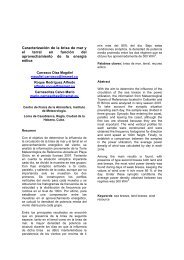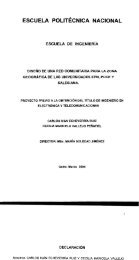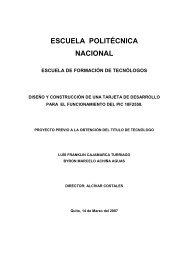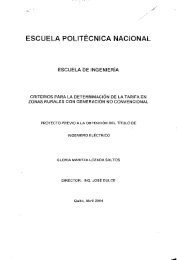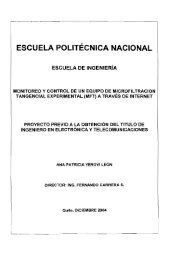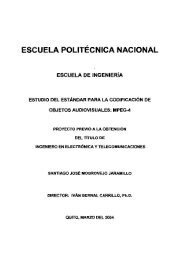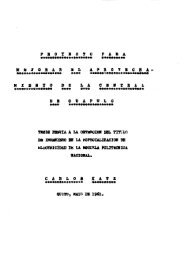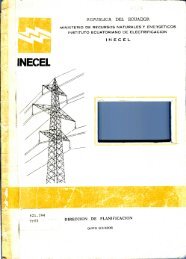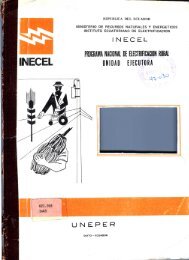Tesis previa a la obtención del Título de Ingeniero en Electrónica y ...
Tesis previa a la obtención del Título de Ingeniero en Electrónica y ...
Tesis previa a la obtención del Título de Ingeniero en Electrónica y ...
You also want an ePaper? Increase the reach of your titles
YUMPU automatically turns print PDFs into web optimized ePapers that Google loves.
) Procedurefor activation and <strong>de</strong>-activation of data channels<br />
1.1 Data equipm<strong>en</strong>t not conforming to Recomm<strong>en</strong>dation H.200/AV.270<br />
Hach terminal must transmit a data-rate capability co<strong>de</strong> (see Recomm<strong>en</strong>dation H.221) for each data rate it Ís able to<br />
'eceive. This may be done during the capability exchange sequ<strong>en</strong>ce at the start of the cali or at a <strong>la</strong>ter time by initíatíng<br />
i new capability exchange,<br />
\ terminal may transmit data at any rate which has be<strong>en</strong> indícated in the data-rate capability co<strong>de</strong>s it has received from<br />
he other terminal (see Note). The appropriate data command (see Recomm<strong>en</strong>dation H.221) is s<strong>en</strong>t and in the following<br />
lub-multiframe the data transmission is comm<strong>en</strong>ced, occupying the bits within each frame <strong>de</strong>fined in Recomm<strong>en</strong><strong>la</strong>tion<br />
H.221. However, at the time the data command is first s<strong>en</strong>t, these bits must be unoccupied or contain only vi<strong>de</strong>o<br />
nformation; therefore audio or any other signáis must be removed from this part of the frame with the prior<br />
ransmission of an appropriate command. In the case of occupancy by vi<strong>de</strong>o ínformation, commands are not avaí<strong>la</strong>ble to<br />
educe the vi<strong>de</strong>o rate, but the vi<strong>de</strong>o <strong>de</strong>co<strong>de</strong>r continúes to opérate correctly on the lower ñow of Ínformation. However, if<br />
he vi<strong>de</strong>o rate is being ma<strong>de</strong> very low (for example, less than 30.4 kbit/s) or slopped altogether by the introduction of a<br />
[ata stream, itis advisable fírstto s<strong>en</strong>d freeze-picture request, followed by the ví<strong>de</strong>o OFF command.<br />
NOTE 1 — Sometimes symmetrícal data transmission ís required, e.g. in data transmission th'rough the V.24/V.28<br />
tlterface. If more than one data rates have be<strong>en</strong> i<strong>de</strong>ntified as common betwe<strong>en</strong> two termináis, asymmetrical data transmission may<br />
ake p<strong>la</strong>ce according to differ<strong>en</strong>t terminal procedures. This can be avoi<strong>de</strong>d by using the highest common rate.<br />
Phe command variable LSD i<strong>de</strong>ntifies as a data path the whole of the I-channel capacity not otherwise allocated by<br />
ither commands; ít must not be used wh<strong>en</strong> variable MLP is on,-or wh<strong>en</strong> another LSD valué is in forcé. If used while<br />
á<strong>de</strong>o is on, vi<strong>de</strong>o is exclu<strong>de</strong>d from the I-channel.<br />
U the conclusión of the data Transmission the data OFF command is s<strong>en</strong>t. If vi<strong>de</strong>o is ON, Ít will th<strong>en</strong> occupy the freed<br />
lits in the next sub-multiframe and thereafter; otherwise those bits remain unoccupied until another command is s<strong>en</strong>t.<br />
U any time during data transmission the rate may be changed by an appropriate data command, subject to the<br />
irovisions gív<strong>en</strong> above.<br />
NOTE 2 — In the case where 64 kbit/s HSD, for example, has be<strong>en</strong> transmitted ín the highest-numbered channel of a<br />
nultiple-B channel connection, a slip during this data transmission would leave a misalígnm<strong>en</strong>t wh<strong>en</strong> the HSD is mrned off. To<br />
voíd corruption of vi<strong>de</strong>o un<strong>de</strong>r these circumstances, it may be advisable to switch off the vi<strong>de</strong>o stream before s<strong>en</strong>díng HSD-off,<br />
witchíng it on again as soon as A = O is received on the erstwhile data channel.<br />
L2 Equipm<strong>en</strong>t operating with an MLP according to Recomm<strong>en</strong>dation H.200/AV.270<br />
iach terminal capable of operating with an MLP must transmit one of the MLP-capability co<strong>de</strong>s. This may be done<br />
luring the capability exchange sequ<strong>en</strong>ce at the start of the cali, or at a <strong>la</strong>ter time by ínitiating a new capability<br />
xchange.<br />
Vh<strong>en</strong> terminal X wishes to transmit MLP, it transmits MLP ON at the appropriate rate. Receiving the <strong>la</strong>tter, terminal<br />
f, must establish an MLP channel at an appropriate rate (not necessarily íhe same rate) Ín the return direction.<br />
'he above provisions apply equally to the use of MLP on the I-channel, or in other channels or time-slots. Normally<br />
nly one of these is required; however if both are in forcé, with appropriaíe commands, th<strong>en</strong> a single MLP sub-channel<br />
t the combíned rate may be interpreted — this would be specified within the appropriate service Recomm<strong>en</strong>dation<br />
s.g. MLP rates of about 100 kbit/s on a 2B cali).<br />
'o change the MLP rate, an appropriate MLP command Ís s<strong>en</strong>t.<br />
'o discontinué use of the MLP, this matter may first be negotiated within the MLP itself; th<strong>en</strong> one or both termináis<br />
ransmitMLP-OFF.<br />
1.3 Simultaneous transmission of low-speed data and MLP<br />
i<br />
,SD and MLP may be active simultaneously, provi<strong>de</strong>d that no over<strong>la</strong>p is implied by the commands in forcé; however,<br />
ariable LSD and variable MLP cannot coexist. No more than one LSD channel and one MLP channel may be active at<br />
nvtimp. fse.R also 1 2X



